This post is coming from you from the middle of the IJsselmeer, the largest lake in the Netherlands. With a group of 25-30 people we are camping on a small fleet of boats (two large ones, plus several smaller ones). Everyone has a task on board, and it won’t come as a surprise that I am the chef 🙂
This means freshly baked multigrain bread every day, on the first night freshly made shawarma, and on the second night we roasted a whole suckling pig over an open fire.
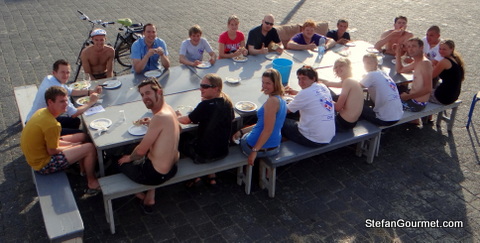
Let me show you my kitchen on board before I tell you what we did with the piggy.

Kees and I own a 20 meter (66 ft) barge. On top of this a shack was built that is our kitchen and bar. As you can see the shack has natural ‘air conditioning’, perfect for the 22C/70F weather we are having.

Of course I brought my sous-vide cooker, but you can’t see it here because it’s up on the shelf. For such a large group a large pot is needed. The paella pan in the corner is also very useful for pan frying.
One feature of this kitchen that is even better than what I have at home is the pizza oven that goes up to 500C/900F and requires 380 volts power (which we do have on the other boat but not at home).

Another nice feature is that at least a dozen of the other guys on board are quite handy and eager to please the chef. So when I ask for a nice rack to allow the freshly baked bread to cool off, this is what I got within 10 minutes!
I like to share my love for food, and this trip is great for that as I’m showing my fellow passengers how nice food can taste without ketchup and the like. For the suckling pig I decided upon a very basic brine (salt, sugar, and water) and a stuffing that was inspired by Richard’s Christmas suckling pig: apple, fennel, onion, and garlic.
Ingredients
1 suckling pig, about 10 kg (22 lbs)
20 liters (5.25 gallons) water
300 grams (0.66 lb) curing salt
120 grams (0.26 lb) sugar
1 bulb fennel, roughly chopped
1 onion, roughly chopped
1 apple, roughly chopped
cloves of 1 garlic bulb, peeled
Preparation
I used a technique called equilibrium brining. Rather than using a traditional brine of 1 cup salt per gallon of water (which has a salt content of almost 3%), I calculated the exact amount of salt to end up with a salt concentration of 1% in the piggy. If you allow the piggy to brine long enough (24 hours), the salt will be evenly distributed in the water and all through the piggy. The piggy cannot become too salty by leaving it in the brine too long, because when the equilibrium has been reached the salt concentration will be 1% in the piggy as well as the brine.
The math for this is quite simple. I needed 20 liters (20 kilograms) of water to cover the piggy. The piggy itself was 10 kilograms. So the total weight of the piggy and the water is 30 kilograms. 1% of that is 300 grams. The brine also needs sugar at a rate of 0.4%, which equals to 120 grams of sugar.
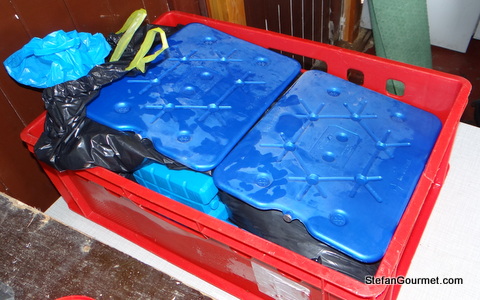
Since we don’t have a refrigerator on board that is large enough to hold the container with the brine and the piggy, I decided to allow the piggy to defrost in the brine. I tried this before with chickens, and this time it also worked like a charm. I used some frozen coolers to regulate the temperature, and monitored the temperature to make sure it remained below 5C/41F. After 24 hours the piggy had defrosted and was brined.

We stuffed the abdominal cavity of the piggy with the stuffing.
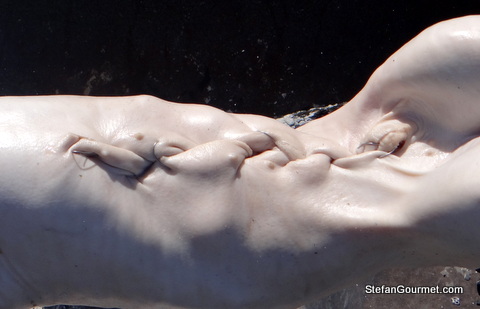
Then we sewed it with metal wire because that’s what we had rather than butcher’s twine.

We stuck a metal rod through the piggy.

We built a moderately hot fire with the glowing embers on both sides of the middle part to avoid flare ups from fat dripping from the piggy.

We trussed up the piggy with some metal pins and more metal wire, and wrapped the ears with aluminum foil to prevent them from burning. The trussing could have been done more neatly, but this was the first time I ever did this and in the end it didn’t make any difference in the end result.
One of my friends on the boat made a rotisserie with an electric engine he had in his boat somewhere, and we let the piggy rotate at about 2 rounds per minute.

After about half an hour over the fire, I rubbed the piggy with olive oil. We kept roasting it, monitoring the fire, until the skin was crispy and a deep golden brown, and the core temperature reached 60C/140F for medium.

The piggy was gone pretty quickly. I didn’t take any pictures of the carving, because I was doing the carving and feeding pieces of the piggy to my friends who were waiting in line (and coming back for second and third helpings). Everyone loved it and was amazed at how much flavor it had, how juicy it was (thanks to the brining) and how the different parts of the animal all had different flavors. My favorite pieces were the more fatty parts on top of the shoulder, although the tenderloin was also outstanding.
This is definitely something I’ll do again if I have a crowd to feed!
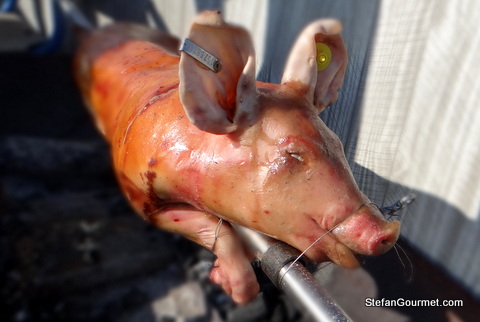
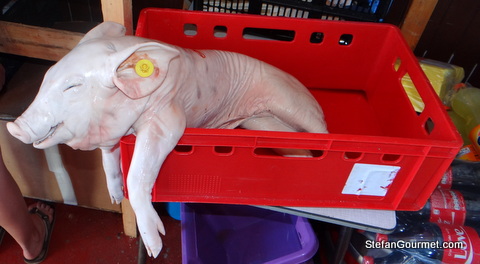

What a nice creation, Stefan! Suckling pigs are always yummy to eat. My fav!
LikeLike
What a fabulous set up in the kitchen!
LikeLike
Tell me, please: how was this little piggy’s pork belly? And my gosh, a kitchen on a barge? Now that’s the high life on a lake in the lowlands. 🙂
LikeLike
You are so lucky! Suckling Pig has been on my bucket list for years 😦
LikeLike
What an incredible experience!
LikeLike
Great post, Stefan. I love how you did the piggy.They are sooo tender and flavorful. I’m sure everyone loved this meal.
LikeLike
Oh crap – I meant to give you A BIG FIVE STARS on this and clicked on two …… So sorry..
In fact, this post deserves more than five stars. What a great bunch of friends, fabulous boat (complete with kitchen) and talk about an amazing way to cook a suckling pig!!
LikeLike
Interesting!
LikeLike
What a great vacation! Now I want a barge with a pizza oven. 🙂 Your friends are so lucky to have you as the chef!
LikeLike
You did a fine job (as usual), Stefan! We did a suckling pig for Father’s day (the Royal we – mostly my daughter and her husband and my hubby). It too was delicious, but troubles were had with the fire and the spit, so it took much longer than anticipated.
LikeLike
The pig looks fantabulous!! And I am certain we all are taking notes . . . at the same time this muxt be the largest galley I have ever seen on a private boat – hope you have kept on having fun!!!!
LikeLike
So, your fun adventure with friends have started! Is there anything you cannot cook, Stefan? Thank you for the detailed post. It is quite informative and interesting!
LikeLike
This is all so inspirational, Stefan – fantastic, there is no other word for it!
LikeLike
Wow, suckling pig! You really did it right, Stefan. Good for you and for your lucky dinner mates.
LikeLike
Thanks, John. It was wonderful and relatively easy to do.
LikeLike